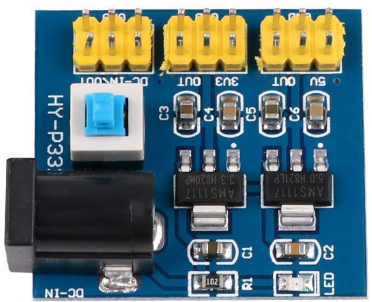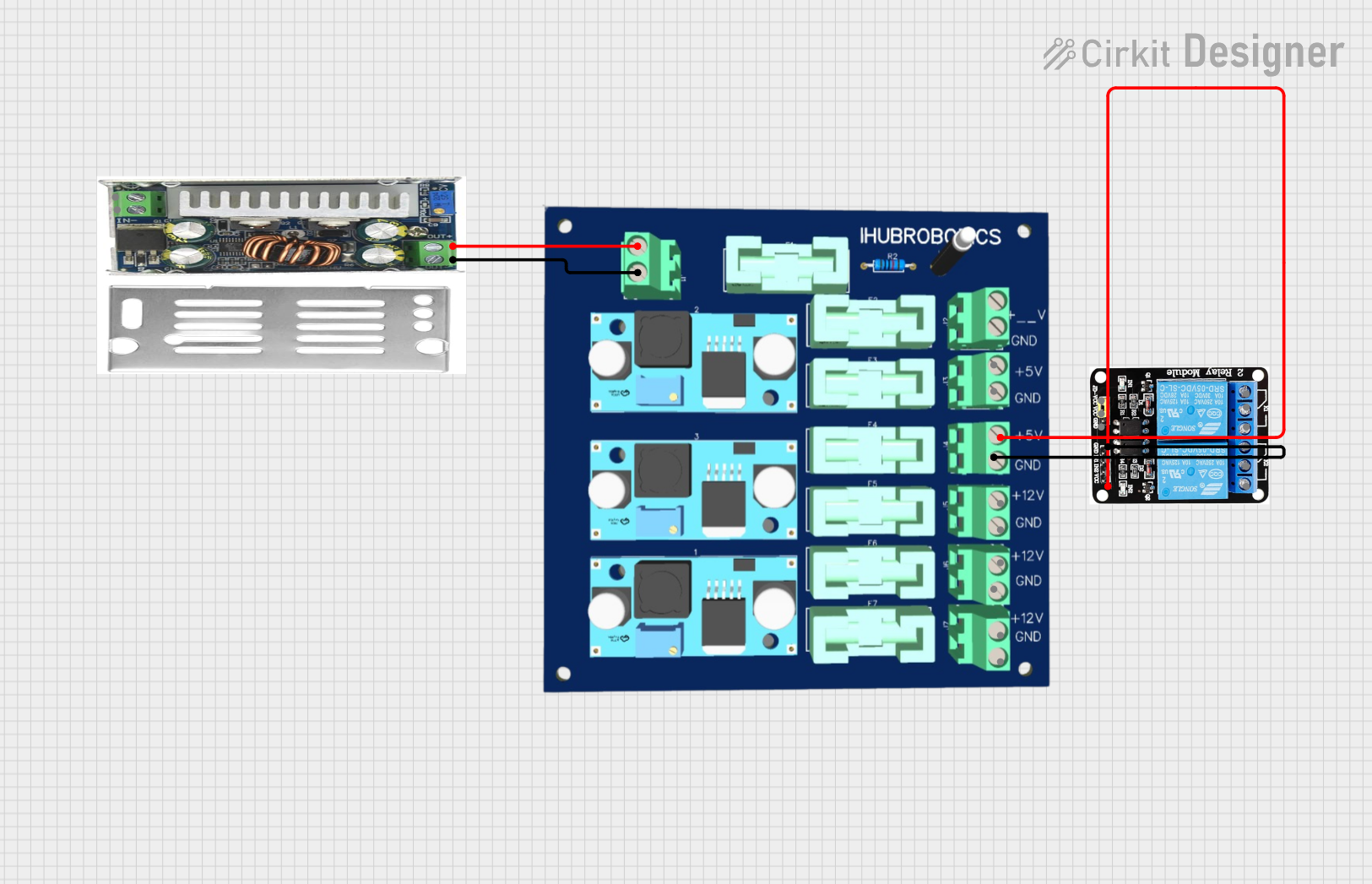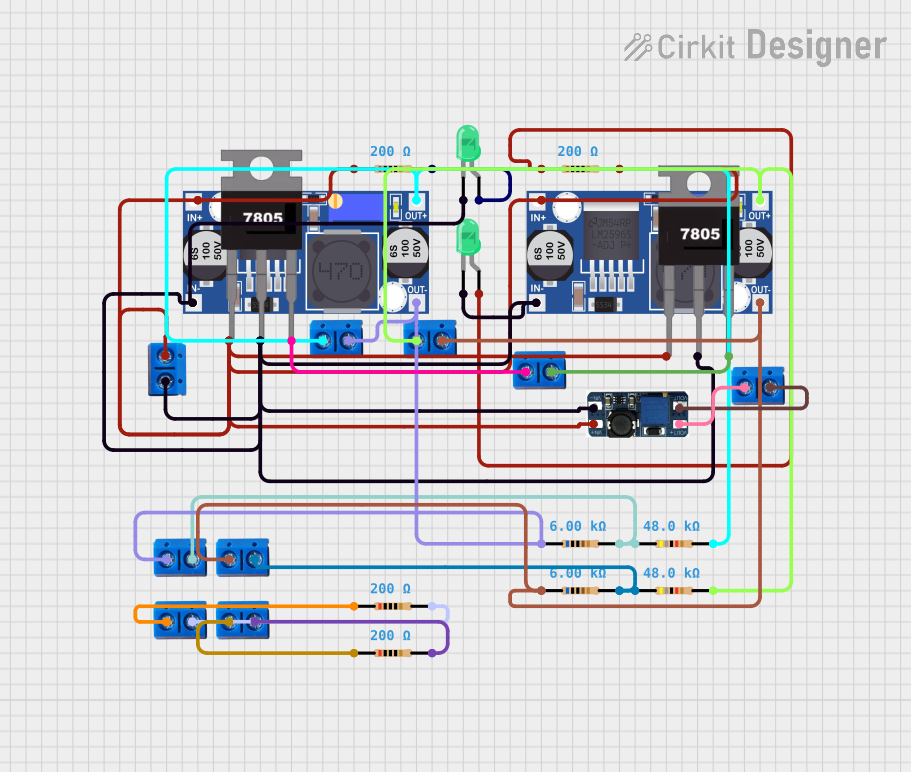
How to Use DC-DC Converter: Examples, Pinouts, and Specs

 Design with DC-DC Converter in Cirkit Designer
Design with DC-DC Converter in Cirkit DesignerIntroduction
A DC-DC converter is an electronic circuit that converts a source of direct current (DC) from one voltage level to another. This component is essential for efficient power management in a wide range of applications, including battery-powered devices, renewable energy systems, and embedded electronics. By stepping up (boosting) or stepping down (buck) the voltage, DC-DC converters ensure that electronic components receive the appropriate voltage for optimal performance.
Explore Projects Built with DC-DC Converter

 Open Project in Cirkit Designer
Open Project in Cirkit Designer
 Open Project in Cirkit Designer
Open Project in Cirkit Designer
 Open Project in Cirkit Designer
Open Project in Cirkit Designer
 Open Project in Cirkit Designer
Open Project in Cirkit DesignerExplore Projects Built with DC-DC Converter

 Open Project in Cirkit Designer
Open Project in Cirkit Designer
 Open Project in Cirkit Designer
Open Project in Cirkit Designer
 Open Project in Cirkit Designer
Open Project in Cirkit Designer
 Open Project in Cirkit Designer
Open Project in Cirkit DesignerCommon Applications and Use Cases
- Powering microcontrollers and sensors in embedded systems
- Voltage regulation in battery-powered devices
- Renewable energy systems (e.g., solar panels, wind turbines)
- Automotive electronics
- Portable chargers and power banks
Technical Specifications
Below are the key technical details for the Arduino-manufactured DC-DC Converter (Part ID: UNO):
General Specifications
- Input Voltage Range: 5V to 24V DC
- Output Voltage Range: 3.3V to 12V DC (adjustable)
- Maximum Output Current: 2A
- Efficiency: Up to 95% (depending on input/output voltage and load)
- Switching Frequency: 150 kHz
- Operating Temperature: -40°C to 85°C
Pin Configuration and Descriptions
The DC-DC converter typically has the following pin configuration:
| Pin Name | Description |
|---|---|
| VIN | Input voltage pin. Connect the DC power source here (e.g., battery or adapter). |
| GND | Ground pin. Connect to the ground of the circuit. |
| VOUT | Output voltage pin. Provides the regulated DC output voltage. |
| ADJ | Adjustment pin. Used to set the desired output voltage (if adjustable). |
Usage Instructions
How to Use the DC-DC Converter in a Circuit
- Connect the Input Voltage:
- Attach the positive terminal of your DC power source to the
VINpin. - Connect the negative terminal of your power source to the
GNDpin.
- Attach the positive terminal of your DC power source to the
- Set the Output Voltage (if adjustable):
- Use a small screwdriver to turn the potentiometer on the converter module.
- Measure the output voltage at the
VOUTpin using a multimeter and adjust until the desired voltage is achieved.
- Connect the Load:
- Attach the positive terminal of your load to the
VOUTpin. - Connect the negative terminal of your load to the
GNDpin.
- Attach the positive terminal of your load to the
- Power On:
- Turn on the DC power source and verify the output voltage before connecting sensitive components.
Important Considerations and Best Practices
- Input Voltage Range: Ensure the input voltage is within the specified range (5V to 24V DC). Exceeding this range may damage the converter.
- Output Current: Do not exceed the maximum output current (2A). Overloading the converter can lead to overheating or failure.
- Heat Dissipation: For high-power applications, consider adding a heatsink or active cooling to prevent overheating.
- Polarity: Always double-check the polarity of your connections to avoid damaging the converter or connected devices.
- Filtering: Add input and output capacitors if the circuit is sensitive to noise or ripple.
Example: Using the DC-DC Converter with an Arduino UNO
Below is an example of how to use the DC-DC converter to power an Arduino UNO with a 12V battery:
Circuit Connections
- Connect the positive terminal of the 12V battery to the
VINpin of the DC-DC converter. - Connect the negative terminal of the battery to the
GNDpin of the converter. - Adjust the output voltage of the converter to 5V using the potentiometer.
- Connect the
VOUTpin of the converter to the5Vpin of the Arduino UNO. - Connect the
GNDpin of the converter to theGNDpin of the Arduino UNO.
Arduino Code Example
// Example code to blink an LED connected to pin 13 of the Arduino UNO
// Ensure the Arduino is powered via the DC-DC converter set to 5V
void setup() {
pinMode(13, OUTPUT); // Set pin 13 as an output
}
void loop() {
digitalWrite(13, HIGH); // Turn the LED on
delay(1000); // Wait for 1 second
digitalWrite(13, LOW); // Turn the LED off
delay(1000); // Wait for 1 second
}
Troubleshooting and FAQs
Common Issues and Solutions
No Output Voltage:
- Cause: Incorrect input connections or insufficient input voltage.
- Solution: Verify the polarity and ensure the input voltage is within the specified range.
Output Voltage is Incorrect:
- Cause: Potentiometer not adjusted properly or load exceeding the converter's capacity.
- Solution: Re-adjust the potentiometer and ensure the load does not exceed 2A.
Overheating:
- Cause: High current draw or poor ventilation.
- Solution: Reduce the load or add a heatsink to the converter.
Noise or Ripple in Output Voltage:
- Cause: Insufficient filtering or high switching frequency interference.
- Solution: Add input and output capacitors to reduce noise.
FAQs
Q1: Can I use this DC-DC converter to power a Raspberry Pi?
A1: Yes, as long as the output voltage is set to 5V and the current requirement of the Raspberry Pi (typically 2.5A for most models) does not exceed the converter's maximum output current (2A).
Q2: Is the output voltage stable under varying loads?
A2: Yes, the converter is designed to provide a stable output voltage. However, ensure the load does not exceed the rated current.
Q3: Can I use this converter with an AC power source?
A3: No, this converter is designed for DC input only. Use a rectifier circuit to convert AC to DC before connecting to the converter.
Q4: How do I know if the converter is damaged?
A4: If there is no output voltage despite correct connections and input voltage, the converter may be damaged. Inspect for visible signs of damage (e.g., burnt components) and replace if necessary.